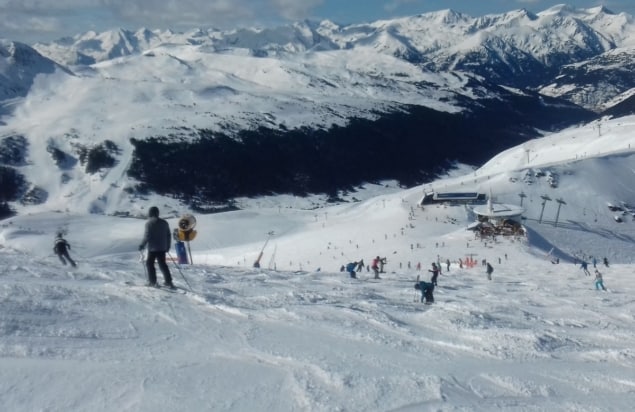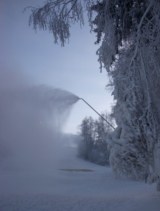
Last week I was at the Grandvalira ski area in Andorra, having a great time whizzing down the slopes in glorious sunshine. Sitting on the chairlifts, my mind naturally turned to the physics involved in maintaining the pistes – and I became fascinated by two things: the moguls that quickly form on an initially smooth slope; and the snowmaking systems that help keep the slopes full of snow.
Nights are very busy at a ski area. Snow cannons hiss as they take advantage of the colder night-time air while huge bulldozer-like “piste bashers” smooth-out the slopes for the next day’s skiing.
After a few hours of being skied on, however, a smooth slope can be covered in moguls – bumps that are about a metre or so across and tens of centimetres high. These tend to form on steeper slopes where skiers control their speed by weaving back and forth across the piste, rather than plunging straight down. Each turn pushes some snow up into a pile and it is easier for successive skiers to weave around these piles, further building them up into a mogul field.
Uphill motion
Like sand dunes, moguls struck me as being ripe for investigation by physicists who study granular materials. A quick Internet search during a coffee break revealed a remarkable thing about moguls – they tend to migrate uphill. That is the conclusion of physicist and skier Dave Bahr and colleagues, who a decade ago trained a camera on an ungroomed mogul field in Colorado for an entire ski season.
The teams’s explanation for this apparent defiance of gravity is that most skiers turn as they go over the top of a mogul. This is because turning involves straightening your knees to lift your upper body, which is much easier to do with the upward boost of a mogul. After the turn, the skier will usually skid along the downhill side of the mogul, pushing some snow down the slope and onto the next mogul. This has the effect of moving both moguls uphill.
In the study, Bahr (along with Tad Pfeffer and Ray Browning) found that the moguls move uphill at a rate of about eight centimetres per day.
Unusually warm
Today, most large ski areas worldwide rely on snowmaking technology to supplement natural snowfall. While snowmaking is seen as a potential solution to global warming, it is not a panacea. It was unusually warm when I was in Andorra, and for several nights the temperature remained well above freezing – even at an altitude of 2100 m. This meant that the snowmaking cannons lining the slopes were not used overnight.
That got me wondering about how snowmaking works – and whether it could be used at air temperatures at or even above 0 °C? Apparently, the answer is yes, under the right conditions.
There are several types of snow cannons but the basic principle involves combining cold water with compressed air and blasting out a mist at high velocity. The sudden drop in pressure at the nozzle cools the water, causing tiny ice crystals to form and grow.
Pellets, not flakes
This nucleation and growth are like what happens in a snow cloud, but at an accelerated rate. It therefore produces a pellet of snow, rather than a flake. While this is no good for powder skiers, this type of snow is apparently better than natural snow for making groomed pistes.
According to the Italian snow-cannon maker TechnoAlpin, snow can be made when the ambient “wet bulb temperature” drops below −2.5 °C. The wet bulb temperature accounts for relative humidity, which is an important factor in snowmaking. The higher the relative humidity, the harder it is to make snow. A wet bulb temperature of about −2.5 °C occurs at about 0.5 °C at 50% relative humidity so snowmaking is possible without freezing air temperatures. Indeed, if the relative humidity is a desert-like 25%, a snow cannon could operate at a balmy 2 °C.
While snowmaking won’t help when temperatures remain above freezing for sustained periods of time, the technology does allow ski areas to make large amounts of snow when it is cold. This snow can then be used to extend the skiing season into the spring. Indeed, some ski areas are looking at storing large quantities of snow over the summer so they can open earlier in the autumn.
There are downsides to snowmaking, however. It takes large amounts of energy to operate cannons and some systems use chemical additives to boost nucleation. And then there is the huge amount of water required – which is often supplied by building alpine reservoirs that can disrupt local hydrology.




